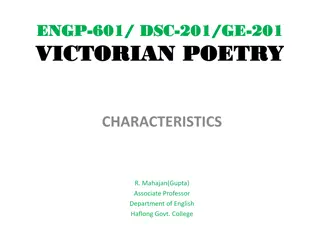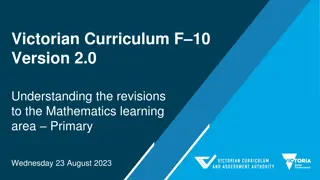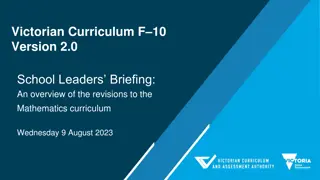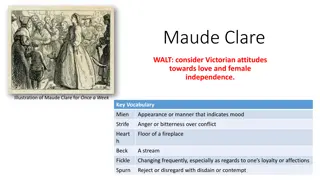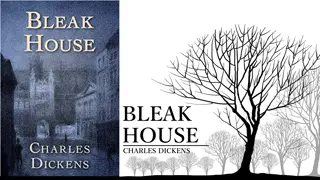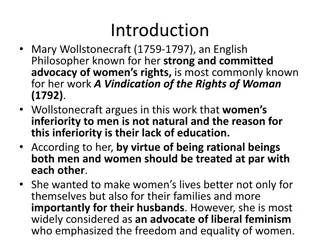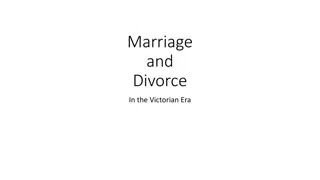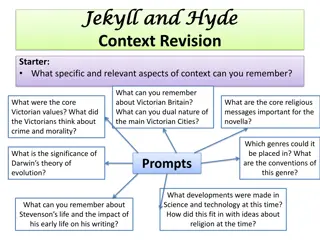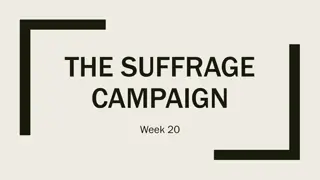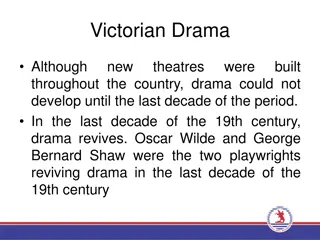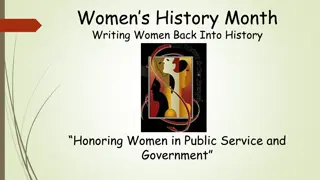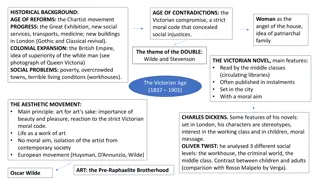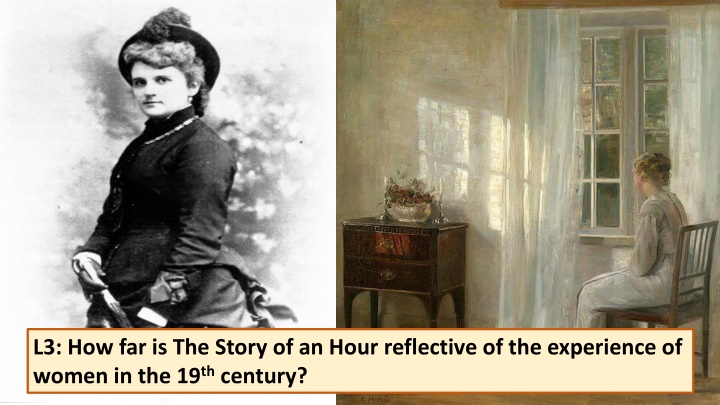
Reflecting on the Victorian Expectations: The Story of an Hour in the 19th Century
Explore how "The Story of an Hour" portrays the constraints of Victorian society on women through the character of Louise Mallard. The narrative delves into the restrictions and societal norms that defined the roles and behaviors expected of women in the 19th century, offering insights into the struggles and desires of women during that era.
Download Presentation

Please find below an Image/Link to download the presentation.
The content on the website is provided AS IS for your information and personal use only. It may not be sold, licensed, or shared on other websites without obtaining consent from the author. If you encounter any issues during the download, it is possible that the publisher has removed the file from their server.
You are allowed to download the files provided on this website for personal or commercial use, subject to the condition that they are used lawfully. All files are the property of their respective owners.
The content on the website is provided AS IS for your information and personal use only. It may not be sold, licensed, or shared on other websites without obtaining consent from the author.
E N D
Presentation Transcript
L3: How far is The Story of an Hour reflective of the experience of women in the 19th century?
Recap questions Recap questions 1. What two references to technology appear in the opening? 2. In what year was the first transcontinental railroad established? 3. What was the Gasconade Bridge disaster and who died in this disaster? 4. What is a telegram? When was the first telegram sent? 5. Why might telegrams be considered problematic, especially for our protagonist, Mrs Mallard? 6. Do you think The Story of an Hour acts as a warning for technological advancement? Do it now
Victorian morality Victorian morality The Story of an Hour was written in 1894. During the Victorian and Edwardian periods society was underpinned by rigid moral and social values; with ideal forms of masculine and feminine behaviour. Moral respectability and domesticity were important ideologies of feminine behaviour. The woman s mission was that of supportive wife, dutiful daughter, and caring mother; and the woman s domestic role was seen as an important pivotal part of society. It was especially important that mothers should teach their children the values of Christian morality, which formed the foundation of society. For men society dictated they take the authoritative role as head of the household. The public sphere of society was controlled by male authority, with very little room for women. New knowledge Source: http://www.ampltd.co.uk/digital_guides/women_and_victorian_values_parts_5_to_7/Publishers-Note-Part- 5.aspx Boys and men Girls and women Per Seyersted: a society where man makes the rules, woman is often kept in a state of tutelage and regarded as property or as a servant. Attended the best schools and trained for various professions. Taught at home and expected to learn how to draw, play the piano and sing. Marriage and serving as support systems for future husbands. Once married, women lost ownership of their wages and all physical property. Creatures of passivity, dependence, submission, weakness and self-sacrifice Could not vote Could not own property In the event of a divorce, would lose all their property to men. Creatures of ambition, independence, action, reason and aggression.
What evidence is there in The Story of an Hour to suggest that What evidence is there in The Story of an Hour to suggest that Louise Mallard was a typical Victorian woman? Louise Mallard was a typical Victorian woman? With sudden, wild abandonment Into this she sank, pressed down by a physical exhaustion that haunted her body and seemed to reach into her soul. She could see in the open square In the street below a peddler was crying his wares. When a sob came up into her throat and shook her, as a child who has cried itself to sleep continues to sob in its dreams. Whose lines bespoke repression But she saw beyond that bitter moment a long procession of years to come that would belong to her absolutely. There would be no one to live for during those coming years; she would live for herself. There would be no powerful will bending hers in that blind persistence with which men and women believe they have a right to impose a private will upon a fellow-creature. And yet she had loved him sometimes. Often she had not. What did it matter! It was only yesterday she had thought with a shudder that life might be long. Pen to paper
What evidence is there in The Story of an Hour to suggest that What evidence is there in The Story of an Hour to suggest that Louise Mallard was a typical Victorian woman? Louise Mallard was a typical Victorian woman? Challenge question: Lousie Mallard s reaction is described through a number of key phrases: She wept at once. the storm of grief. She knew that she would weep again when she saw the kind, tender hands folded in death. And yet she had loved him sometimes. Pen to paper Are the quotations above evidence that Louise Mallard loved her husband. Is it possible to truly love someone who controls you? Is it love or is it shock?
Louise Mallard is based upon Eliza OFlaherty. Brently Mallard s name comes from two of the other victims of the Gasconade Bridge collapse. Eliza also has a sister named Josephine. It was said that Eliza O Flaherty s marriage to Thomas O Flaherty was an arranged one. New knowledge Based upon what we know about women during the Victorian era and the nature of Eliza and Thomas s marriage, the story could be read as a criticism of marriage as an institution that traps women. Upon the death of her father, Eliza O Flaherty was determined to bring her daughter, Kate, home from the boarding school she was attending. A boarding school that her father had enrolled her at when she turned five. Eliza was determined that she would be making the decisions about her daughter. It could also be argued, therefore, that the story is about Kate discovering her own freedom.
There are many parallels (similarities) between the character of Louise Mallard and Eliza O Flaherty. Reflection 1.What are these parallels? 2.How far do you think writer s own experiences influence their work? 3.Can you think of any other texts you have read that have had close links to the life of the author?

